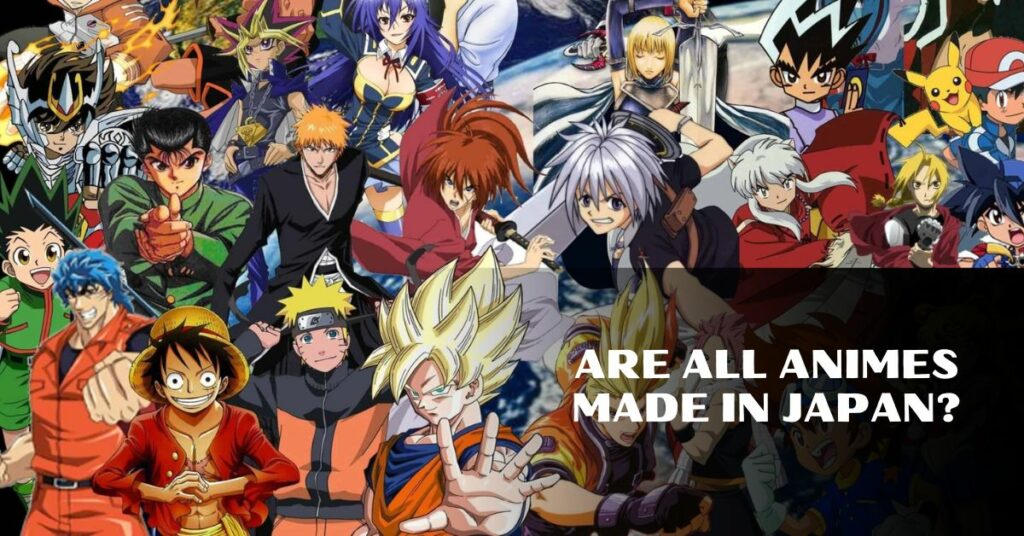You settle into your favorite chair, snuggle under a cozy blanket, and power on your screen for an epic anime binge-watching session. As vibrant characters and intricate plots unfold, you can’t help but wonder: is all this incredible animation really originating from Japan? It might seem like a simple question, but the answer meanders through a colorful history of international collaboration, artistic influence, and the ever-evolving global anime industry. Join us as we journey across countries and continents to uncover the truth behind the origin of your favorite animated masterpieces. Are all animes genuinely made in Japan, or is there more to this cultural phenomenon than meets the eye? Grab your popcorn, dear readers, as we’re about to find out!
1. Introduction to Anime and Its Origins in Japan
When I first dived into the world of anime, I was fascinated by its unique art style, engaging storytelling, and diverse genres. Originating in Japan, anime has a rich history that can be traced back to the early 20th century, with the earliest verifiable films dating from 1912. Before the arrival of film, Japan already had a vibrant entertainment scene that featured colorful painted figures moving across projection screens in utsushi-e, a unique type of show popular in the 19th century. In the late 1910s, the second generation of Japanese animators emerged, laying the foundation for what is now universally known and beloved as anime. Today, anime continues to draw fans from around the globe with its captivating stories and beautifully crafted visuals.
2. Definition and Origins of the Term
When it comes to defining the term “anime,” it’s essential to understand its origins and cultural connotations. The word “anime” is short for “animation” and is derived from the Japanese pronunciation of the term. Interestingly, in Japan, this word is often used as a blanket term for all animated content, regardless of its country of origin. This means that, in Japan, both Dragon Ball and Disney could be considered anime because they are both animated.
However, outside of Japan, some staunch fans of the genre might argue that the term “anime” is reserved only for animated content created in Japan. This seemingly minor distinction has led to intense debates and differing opinions on what can truly be classified as anime. As cultural influences and artistic styles continue to evolve, defining the term “anime” remains a contentious issue with no straightforward answer.
3. Characteristics of Japanese Anime
As a huge fan of Japanese anime, I’ve noticed that there are certain characteristics that make anime unique compared to other forms of animation. One of the most distinguishing features is the use of large and emotive eyes, giving the characters an expressive quality. In terms of art style, anime covers a diverse range, but they often pay close attention to details, especially in backgrounds and settings. Another interesting aspect is that anime often focuses more on camera effects like panning, zooming, and angle shots, rather than solely on movement. Additionally, anime spans across various genres, catering to a wide audience, and can be enjoyed by both children and adults. If you’ve never tried watching Japanese anime, I highly recommend giving it a shot!
4. Production and Distribution of Anime in Japan and Worldwide
As an avid anime fan, I’ve always wondered about the production and distribution of anime in Japan and worldwide. Did you know that Japan is one of the largest producers of animation in the world? In fact, they produce over 6,000 anime and around 3,200 of them are aired on television. The anime industry is made up of more than 430 anime production studios, some of which are quite well-known, like Studio Ghibli, Production IG, and Toei Animation.
Anime has been growing in popularity worldwide ever since animators like Osamu Tezuka introduced their distinctive artistic styles and production techniques in the 1960s. It’s amazing to see how these art forms have evolved and are now enjoyed by a vast international audience across various platforms, such as theatres, TV broadcasts, and online streaming services. I’m grateful to be part of this global fan base and I can’t wait to see where the world of anime goes next!
5. Adaptation of Anime from Japanese Comics or Novels
As an avid anime fan, I couldn’t help but notice how many of my favorite are actually adaptations of Japanese comics, or manga, and novels. This should come as no surprise, given that Japan has a rich literary tradition and a thriving manga industry. In fact, a significant portion of anime series borrow their storylines and characters from these sources. Some popular examples include “Naruto”, “Attack on Titan”, and “My Hero Academia”, all of which were originally published as manga. These adaptations allow fans to see their beloved stories come to life in a different medium, complete with stunning visuals and engaging voice acting. It’s fascinating to see how these adaptations help expand the audience and enhance our appreciation of these captivating tales.
6. Genres and Target Audiences of Anime
As an anime fan, I find that one of the remarkable things about this form of visual storytelling is the diversity in its genres and target audiences. Contrary to popular belief, anime is not just for kids or teens – there’s something for everyone! For instance, we have ‘shonen’ anime, which attracts young male viewers with its action-packed scenes and dynamic protagonists. On the other hand, ‘shoujo’ anime appeals to young females with its focus on romance, friendship, and personal growth. Additionally, there are also genres such as ‘seinen’ and ‘josei’ that cater to adult male and female audiences, respectively, featuring complex plots, mature themes, and deeper character developments. So, whatever your taste in storytelling might be, rest assured that there’s an anime out there just for you!
7. Artistic Techniques and Styles in Anime
Artistic techniques and styles in anime truly showcase the diversity and creativity of this fantastic art form. As a fan of anime, I can’t help but marvel at the various techniques used to bring these animated stories to life. One primary characteristic that differentiates anime from Western animation is its focus on detailed settings and the use of camera effects such as panning, zooming, and angle shots. This enhances the overall aesthetic and adds a sense of depth to the visuals. Character proportions and features can also be varied greatly, with the signature large, emotive eyes being a common trait. As I watch more shows, I find myself continually fascinated by the different art styles and animation techniques applied to create truly memorable, unique stories.
8. Debate over Whether Animated Shows Outside Japan Can Be Called Anime
There’s an ongoing debate among anime enthusiasts about whether animated shows created outside Japan can be called anime or not. On one hand, anime is a Japanese loanword used to refer to any sort of animation. In Japan, the term anime encompasses all animated content, regardless of its origin. On the other hand, many fans in the Western world firmly believe that the term should exclusively be used for Japanese animation. They suggest that animation from other countries can be “anime-inspired” or “anime-style” but should not be referred to as anime. As would be expected, this debate has no clear consensus yet, and the definition of the term “anime” remains as blurry as ever.
9. Examples of Animated Shows Produced Outside Japan that Resemble Anime
As an avid anime fan, I’ve noticed that there are several animated shows produced outside of Japan that closely resemble the anime style we all know and love. These are just a few examples of such shows; “Avatar: The Last Airbender,” an American series, is a perfect example of a non-Japanese show that has drawn inspiration from traditional anime. Another example is “RWBY”, created by the American company Rooster Teeth. Even the French show “Code Lyoko” showcases anime-like character designs and storytelling elements. While these shows may not be authentic Japanese anime, they still pay homage to the unique stylings that make anime so captivating.
10. Conclusion: Understanding the Unique Cultural and Artistic Characteristics of Anime.
In conclusion, the world of anime is truly a unique and fascinating cultural phenomenon that reflects various aspects of Japanese culture. The artistic and narrative intricacies of this beloved medium captivate audiences around the world, creating a global community who appreciate and celebrate Japan’s signature animation style. It is important to always remember the cultural roots and artistic values that made anime what it is today, as well as recognize the diverse range of stories and themes it covers. By understanding the unique cultural and artistic characteristics of anime, we can further appreciate its beauty and richness, and continue to enjoy this incredible form of art and entertainment.

Meet Michael Graham, the main author of SeekTraveler.com. With a wanderlust that knows no bounds, Michael has traversed more than 30 countries across the globe. From sun-soaked Caribbean islands to the ancient marvels of Europe and the captivating charm of Japan, he has witnessed the wonders of diverse cultures firsthand. Michael’s in-depth knowledge and contagious enthusiasm for travel will inspire you to pack your bags and embark on your own extraordinary journey.



